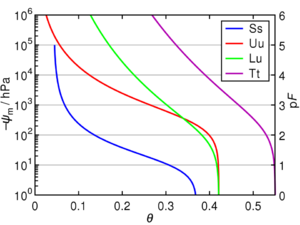
Difference between revisions of "Soil hydrologic properties and processes"
m () |
m () |
||
| Line 24: | Line 24: | ||
*Video: [https://mediahub.unl.edu/media/6081 Water content calculations] | *Video: [https://mediahub.unl.edu/media/6081 Water content calculations] | ||
| − | *Video: | + | *Video: [https://www.youtube.com/watch?v=SGHVcMoET5k Gravimetric and volumetric water content] |
Revision as of 14:04, 23 June 2021
This site is currently undergoing revision. For more information, open this link.
This page is not yet developed
This page is not yet developed
Soil hydrologic (hydraulic) properties include infiltration and water retention. These properties significantly affect plant growth, pollutant transport, and subsurface water transport (e.g. groundwater recharge).
Soil water and water retention
Understanding some basic terms related to soil water is important to understanding water storage and transport.
- Soil water (moisture) content can be expressed on a mass or volume basis. This video describes the two measurements and how they are related.
- Gravimetric water content: the ratio of the mass of water held in the soil to the dry soil.
- Volumetric water content: the ratio of the volume of water to the unit volume of soil. Volumetric water content can be expressed as a ratio (e.g. cm3/cm3), percentage (e.g. 50% of the soil volume), or depth of water per depth of soil (e.g. centimeters per meter of soil).
- Example: assume a wet soil weighs 50 grams, a dry soil 40 grams, and soil bulk density is 1.3. Gravimetric water content is ((0.5-0.40)/0.40) = 0.10/0.40 = 0.25 g/g. To derive volumetric water content, multiply the gravimetric water content by the bulk density and divide by density of water (1.0 g/cm3). Volumetric water content is therefore 0.25*1.3/1.0 = 0.325 cm3/cm3, or 32.5%.
- Water holding capacity: the total amount of water a soil can hold at field capacity.
- Field capacity: the amount of soil moisture or water content held in the soil after excess water has drained away and the rate of downward movement has decreased. Physically it is the water content retained in soil at −33 kPa (or −0.33 bar) of hydraulic head or suction pressure.
- Wilting point: the volumetric water content in the soil is too low for the plant's roots to extract water. When the water content of a soil is below the permanent wilting point, water is still present in the soil, but plant roots are unable to access it. Physically, it is the water content at −1,500 kPa (−15 bar) of suction pressure.
- Moisture retention curve: the relationship between the water content (θ), and the soil water potential (ψ), typically expressed as a curve. The curve is characteristic for different types of soil and is therefore also called the soil moisture characteristic.
For more reading
